Star Center
-
- STAR Center Provides 360-Degree Field of View Maritime Reporter, Jul 2002 #41
Imagine having your employer inform you that your only two-week vacation all year will be spent sitting in training courses to revamp or add to your skill base as an officer. Most would more than likely offer a collective groan of discontent by this suggestion since they often spend more than four months at sea in one given shot. Time spent away from relaxation with their families is precious to these individuals as it is hard to come by. Therefore RTM Star (Simulation, Training, Assessment & Research) Center, located in Dania Beach, Fla. And Toledo, Ohio, strives to give students who come to the training center an atmosphere that exudes a "home away from home" environment.
By Regina P. Ciardiello, managing editor Driving along the industrious thoroughfare of U.S. I (or Federal Highway, as the locals call it), stands a building on the corner of West Dixie Highway that could easily be mistaken for a country club. Entering RTM STAR Center's Dania Beach. Fla. facility, guests and students are greeted by tall palm trees, maintenance people on golf carts and neatly lined and labeled guest rooms (125 to be exact), as well as an outdoor swimming pool, exercise facility and movie theatre. The facility also boasts what it is the largest and one of the most comprehensive training facilities for merchant mariners and officers. The Center is always researching its course offerings to offer students the most upto date classes, and is home to the world's only 360-degree Full Mission Bridge Simulator, which is complemented by the center's Slow Speed and Medium Speed Diesel Simulators.
The Bridge Simulator, which provides an immense 360-degree view of realtime, at-sea situations, is an invaluable training tool that features a Litton Sperry 2100 Integrated Bridge System (IBS) — similar to the one found on RCCL's Voyager of the Seas. This one-of-a-kind device boasts podded propulsion capability, as well as Dynamic Positioning (DP) capability, and is set off by the Center's 250-degree bridge simulator.
Walking into the simulation room, is much like stepping into a virtual reality-type ride at Epcot Center in Disney World. Star Center made MR/EN right at home by displaying a real time at sea "scene" of New York Harbor — complete with the Verrazano Bridge, Liberty Island and Governor's Island in the distance. While officers command the controls of the simulator, simulator operators located in an adjacent room throw many situations in their directions — many that could be life threatening or pose imminent danger. When MR/EN visited Star Center, the operators provided a scenario on a tanker traveling through New York Harbor in both the day and evening. In the vessel's field of vision lay the New York skyline, as well as several types of ships cruising through the harbor on a busy day. The simulator operators threw anything and everything in the tanker's path, from small sailboats to U.S. Navy destroyers to containerships. and could include, for example, a U.S. Coast Guard helicopter cruising overhead looking for landing spot, or a bevy of media helicopters covering a high-publicity event, such as Fleet Week. The officers at STAR Center even go as far as to communicate to the students via "staged" traffic on the simulator's radio. According to Graeme Holman, STAR Center's head of Customer Service & Operations, the simulator is capable of running a variety of situations. "The simulator can be changed from port to starboard side, can mimic an oil spill and even change the wind and current speed. Mariners who are trained on this system will always say that this is how a ship is handled in real time situations." Evolution of a Major Training Facility Since opening its doors to the maritime community in the winter of 1993, STAR Center's three-story building at its Florida facility has expanded rapidly, an expansion which includes additional floors on the original building and the commencement of operations in Toledo, Ohio for training on inland waterways and Great Lakes. STAR Center is preparing for the grand opening of its new waterfront training facility located in Fort Lauderdale — just minutes from its Dania Beach facility. While fast craft training is not new to STAR Center, according to Jerry Pannell, head of STAR Center's Deck department, the center, (which in the past had to rent out fast rescue craft from a shorebased facility), will now have this "self contained facility" approximately 2.5 miles from its main training grounds. The new center, which at press time was scheduled for a mid-August opening, will house one 18-ft. (5.5-m) and two 26-ft. (8-m) fast rescue boats, a single-point davit for launching and recovering boats, enclosed SOLAS certified lifeboat, davit launchable liferaft, as well as classrooms and workshops.
Designed to meet STCW '95 compliant training, and are U.S.C.G. approved, the curriculum followed at this new center will focus on Proficiency in Fast Rescue Boat and Proficiency in Survival Craft.
A spitting image of a diesel electric engine onboard a traditional cruise ship, the Center' Full Mission Diesel Electric Engineroom Simulator puts the "real" in real time as it is based on a large cruise ship running on 40 MW of power at 6,600 volts. When MR/EN was hosted by Dwight Hutchinson, STAR Center's director.
Quality and Engineering, he explained how students operate the simulator's controls, which run on Kongsberg Maritime Ship Systems (KMSS) software. The simulator, which is actually the former engine plant from the cruise ship Sun Princess, boasts four diesel generator sets connected to two 14 MW synchronous propulsion motors. Four thrusters and two emergency generators are also part of the simulated vessel's power package — based on a 77,000 grt with a cruising speed of 18.5 knots. Hutchinson also mentioned that this past May, STAR Center has furthered its commitment to providing the highest grade of advanced training via its recent transition to ISO 9000:2000 certification. This award, which was granted by the Center via a third party conversion audit by Det Norske Veritas, recognizes the Center as the only training facility in the U.S.
to hold this type of certification. While the staff at STAR Center realizes that the certification puts the facility in a high regard, it also translates to more time researching and upgrading its curriculum and programs.
This, however is not foreign to the facility, as its instructors and full time staff already have a handle on this — specifically Capt. A1 Stiles, who is the Center's Curriculum & Program Development Dept. Head.
According to Stiles, approximately 60 percent of the Center's course offerings are cruise-oriented, and, as always, have been tailored to meet the requirements of each individual cruise line.
Circle 218 on Reader Service Card
-
- RTM STAR Center Upgrades Full Mission Bridge Simulator Maritime Reporter, Feb 2002 #44
Center has announced the upgrade and modernization of its 247-degree "field-of-view" Full Mission Bridge Simulator. The simulator is located at STAR Center's Dania Beach, Fla., facility and is based on a design by Kongsberg Maritime Ship Systems Inc. (KMSS). Following the successful upgrade of STAR
-
- World's First Full Mission Diesel Electric Simulator Debuts Maritime Reporter, Jan 2002 #49
RTM STAR Center (Simulation, Training, Assessment and Research) has installed what it dubs the world's first Full Mission Diesel Electric Simulator - DE III. The simulator is located at STAR Center's Dania Beach. Fla., facility and is based on a previous design by Kongsberg Maritime Ship Systems.
-
- Resolve Installs New Engine Room Simulator Maritime Reporter, Jan 2014 #56
with nine years of experience in maritime education (and 12 years of at-sea experience) to manage the ERS 5000 TechSim. Mackay joins the Academy from Star Center, where she instructed classes offered at the Star Center Engineering Department and was directly involved in course design and development. The
-
- The Crowley Way Maritime Logistics Professional, Q1 2014 #32
wake of “a string of incidents that caused us great concern.” The premise was a program – executed in three simulator centers including PMI, MITAGS and STAR Center – was to provide a uniform assessment program for captains. “There was no program that assesses our captains, so we created this environment within
-
 )
March 2024 - Marine Technology Reporter page: 26
)
March 2024 - Marine Technology Reporter page: 26FEATURE OCEANOGRAPHIC INSTRUMENTATION & SENSORS Kevin Mackay, TESMaP voyage leader and Center head of the South and West Paci? c Regional Centre of Seabed 2030. Kevin in the seismic lab at Greta Point looking at the Hunga Tonga-Hunga Ha’apai volcano 3D map completed with data from the TESMaP voyage
-
 )
March 2024 - Marine Technology Reporter page: 25
)
March 2024 - Marine Technology Reporter page: 25of Japan mobilized away still had abundant life, including the Tonga Eruption Seabed Mapping Even before the recent HT-HH erup- corals, sponges, star? sh and mussels. Project (TESMaP) to understand the ex- tion, subsea technology helped scien- This indicated the resilience of certain tent of impact
-
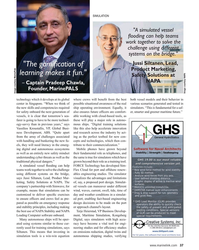 )
April 2024 - Maritime Reporter and Engineering News page: 37
)
April 2024 - Maritime Reporter and Engineering News page: 37SIMULATION "A simulated vessel ? ooding can help teams work together to solve the challenge using different systems on the bridge." – Jussi Siltanen, Lead, "The gami? cation of Product Marketing, learning makes it fun." Safety Solutions at NAPA – Captain Pradeep Chawla, Founder, MarinePALS Image
-
 )
April 2024 - Maritime Reporter and Engineering News page: 35
)
April 2024 - Maritime Reporter and Engineering News page: 35SIMULATION e have a close relationship with tech- Realism is prized beyond immersive, photo-realistic visu- nology, evidenced by, for example, als, and providers are introducing increasingly accurate func- the phones we are estimated to un- tionality. FORCE Technology’s upcoming DEN-Mark2 math- lock around
-
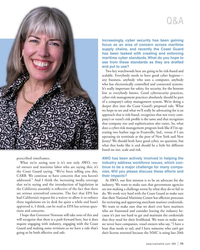 )
April 2024 - Marine News page: 11
)
April 2024 - Marine News page: 11Q&A Increasingly, cyber security has been gaining focus as an area of concern across maritime supply chains, and recently the Coast Guard has been tasked with creating and enforcing maritime cyber standards. What do you hope to see from these standards as they are drafted and put to use? Two key
-
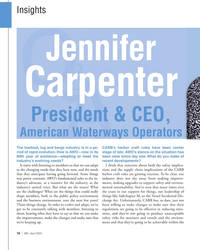 )
April 2024 - Marine News page: 10
)
April 2024 - Marine News page: 10has 80th year of existence—adapting to meet the been clear since day one. What do you make of industry’s evolving needs? recent developments? It starts with listening to members so that we can adapt I think that concerns about both the safety implica- to the changing needs that they have now, and
-
 )
February 2024 - Maritime Reporter and Engineering News page: 44
)
February 2024 - Maritime Reporter and Engineering News page: 44Tech Files Latest Products & Technologies MarineShaft Yanmar Hydrogen MarineShaft specializes in urgent re- Fuel Cell AIP pair/replacement of damaged rudder and Yanmar Power Technology Co., Ltd. propeller equipment along with many (Yanmar PT), a subsidiary of Yanmar on-site repair services. MarineShaft
-
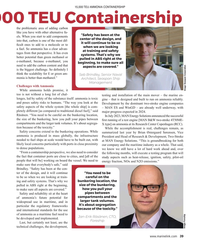 )
February 2024 - Maritime Reporter and Engineering News page: 39
)
February 2024 - Maritime Reporter and Engineering News page: 39CONTAINERSHIP 000 TEU Containership the problematic area of adding carbon like you have with other alternative fu- “Safety has been at the els. When you start to add components center of the design, and into that, carbon is one of the most dif- it will continue to be so ? cult ones to add to a molecule
-
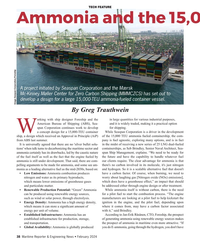 )
February 2024 - Maritime Reporter and Engineering News page: 38
)
February 2024 - Maritime Reporter and Engineering News page: 38“Green” Ammonia While ammonia itself is without carbon, there is the need can be produced using renewable energy sources, for a pilot fuel to start the combustion process. “The engine such as wind or solar power, through electrolysis. manufacturers are looking at a pilot fuel to help kickstart
-
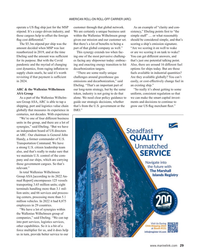 )
February 2024 - Maritime Reporter and Engineering News page: 29
)
February 2024 - Maritime Reporter and Engineering News page: 29AMERICAN ROLL-ON ROLL-OFF CARRIER (ARC) operate a US ? ag ship just for the MSP customer through that global network. As an example of “clarity and con- stipend. It’s a cargo driven industry, and We are certainly a unique business unit sistency,” Ebeling points ? rst to “the those cargoes help to
-
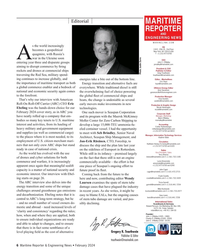 )
February 2024 - Maritime Reporter and Engineering News page: 6
)
February 2024 - Maritime Reporter and Engineering News page: 6.631.472.2715 economic interest. Our interview with Ebel- Coming back from the future to the Frank Covella [email protected] | +1.561.732.1659 ing starts on page 26. here and now, contributing editor Wendy Tricia Garrett The ARC interview also delves into the Laursen examines the spate of stern
-
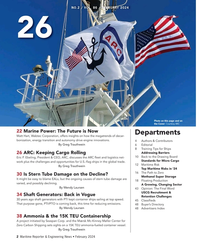 )
February 2024 - Maritime Reporter and Engineering News page: 2
)
February 2024 - Maritime Reporter and Engineering News page: 2NO.2 / VOL. 86 / FEBRUARY 2024 26 Photo on this page and on the Cover: Courtesy ARC 22 Marine Power: The Future is Now Departments Matt Hart, Wabtec Corporation, offers insights on how the megatrends of decar- bonization, energy transition and autonomy drive engine innovations. 4 Authors & Contributors By
-
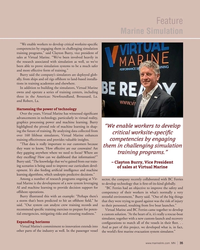 )
February 2024 - Marine News page: 35
)
February 2024 - Marine News page: 35Feature Marine Simulation “We enable workers to develop critical worksite-speci? c competencies by engaging them in challenging simulation training programs,” said Clayton Burry, vice president of sales at Virtual Marine. “We’ve been involved heavily in the research associated with simulation as well
-
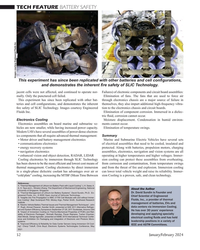 )
January 2024 - Marine Technology Reporter page: 52
)
January 2024 - Marine Technology Reporter page: 52TECH FEATURE BATTERY SAFETY Images courtesy Engineered Fluids Inc. This experiment has since been replicated with other batteries and cell con? gurations, and demonstrates the inherent ? re safety of SLIC Technology. jacent cells were not affected, and continued to operate nor- Failures) of electronic
-
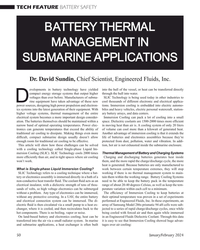 )
January 2024 - Marine Technology Reporter page: 50
)
January 2024 - Marine Technology Reporter page: 50TECH FEATURE BATTERY SAFETY BATTERY THERMAL MANAGEMENT IN SUBMARINE APPLICATIONS Dr. David Sundin, Chief Scientist, Engineered Fluids, Inc. evelopments in battery technology have yielded into the hull of the vessel, or heat can be transferred directly compact energy storage systems that output higher
-
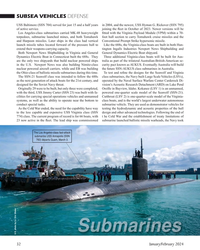 )
January 2024 - Marine Technology Reporter page: 32
)
January 2024 - Marine Technology Reporter page: 32SUBSEA VEHICLES DEFENSE USS Baltimore (SSN 704) served for just 15 and a half years in 2004, and the newest, USS Hyman G. Rickover (SSN 795) of active service. joining the ? eet in October of 2023. Newer versions will be Los Angeles-class submarines carried MK-48 heavyweight ? tted with the Virginia
-
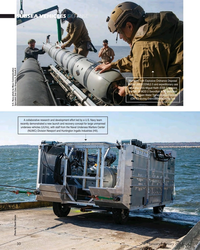 )
January 2024 - Marine Technology Reporter page: 30
)
January 2024 - Marine Technology Reporter page: 30SUBSEA VEHICLES DEFENSE Members from Explosive Ordnance Disposal Mobile Unit (EODMU) 5 and expeditionary sea base ship USS Miguel Keith (ESB 5) prepare the MK 18 MOD 2 Sword? sh to be deployed from the Open Water Transportation System (OWTS) during Exercise Noble Vanguard. U.S. Navy photo by Mass
-
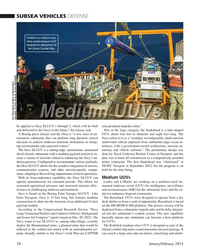 )
January 2024 - Marine Technology Reporter page: 28
)
January 2024 - Marine Technology Reporter page: 28SUBSEA VEHICLES DEFENSE Knife? sh is a medium-class mine countermeasure UUV designed for deployment off the Littoral Combat Ship. U.S. Navy photo by Mass Communication Specialist 1st Class Brian M. Brooks/RELEASED be applied to Orca XLUUV 1 through 5, which will be built (encapsulated torpedo) mine.
-
 )
January 2024 - Marine Technology Reporter page: 27
)
January 2024 - Marine Technology Reporter page: 27Snakehead is a modular, recon? gurable, multi-mission underwater vehicle deployed from submarine large ocean interfaces, with a government-owned architecture, mission autonomy and vehicle software. Photo by Richard Allen, Naval Undersea Warfare Center Division Newport www.marinetechnologynews.com
-
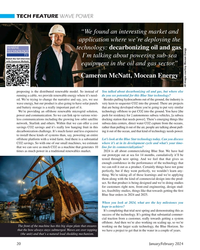 )
January 2024 - Marine Technology Reporter page: 20
)
January 2024 - Marine Technology Reporter page: 20You talked about decarbonizing oil and gas, but where else running a cable, we provide renewable energy where it’s need- do you see potential for this Blue Star technology? ed. We’re trying to change the narrative and say, yes, we use Besides pulling hydrocarbons out of the ground, the industry is wave energy
-
 )
January 2024 - Marine Technology Reporter page: 18
)
January 2024 - Marine Technology Reporter page: 18Energy, led by founder and managing director Cameron McNatt, is aiming to help offshore companies power up it’s offshore and sea? oor assets with its Blue Star system. A 10kW Blue Star prototype now has more than 14 months of operational experience under its belt, and the goal for 2024 is completion of that
-
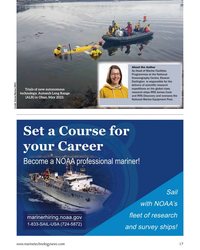 )
January 2024 - Marine Technology Reporter page: 17
)
January 2024 - Marine Technology Reporter page: 17About the Author As Head of Marine Facilities Programmes at the National Oceanography Centre, Eleanor Darlington is responsible for the delivery of scienti? c research expeditions on the global class Trials of new autonomous research ships RRS James Cook technology, Autosub Long Range and RRS
-
 )
January 2024 - Marine Technology Reporter page: 14
)
January 2024 - Marine Technology Reporter page: 14INSIGHTS SCIENCE RESEARCH MANAGEMENT © Who is Danny/AdobeStock PAVING THE WAY IN INTERNATIONAL SCIENCE RESEARCH MANAGEMENT Dr. Eleanor Darlington, Head of Marine Facilities Programs at the National Oceanography Centre (NOC), discusses how NOC is paving the way in international science research
-
 )
January 2024 - Marine Technology Reporter page: 8
)
January 2024 - Marine Technology Reporter page: 8stationary targets, such as anchored vessels tack, or more high-tech measures, such as electronic warfare or coastal infrastructure. These designs lie in stark contrast to to disrupt communication between drone and operator. They the dominant combat AUV design paradigm for larger navies are also vulnerable
